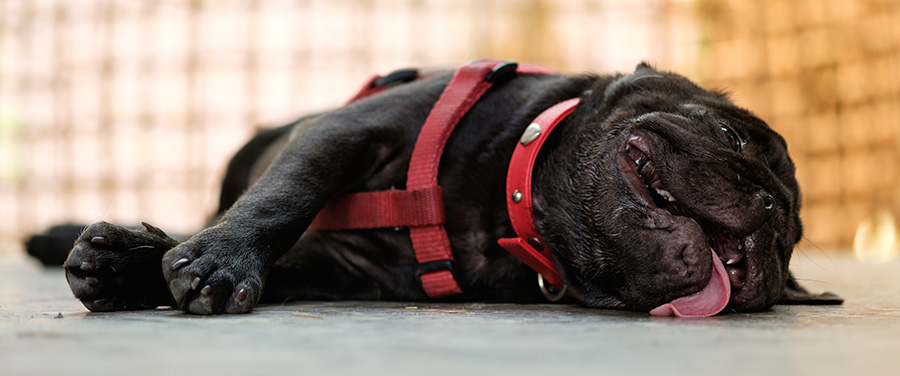Posts Tagged: Keeping them comfortable
Pet Arthritis is Common and Treatable

By Dr. Maria Krenz, DVM – ZimmVet-763-856-4848
Pet arthritis can affect any age, sex, or breed of dog and cat. Research shows that arthritis is diagnosed in 25 percent of dogs in their lifetime, and x-ray evidence shows arthritis in 60 percent of dogs. In one study, 90 percent of cats over 12 years of age had x-ray signs of osteoarthritis. As your pet ages, wear and tear on their joins can lead to primary arthritis. Secondary arthritis is the result of an injury that once damaged the joint cartilage. Some pets can be born with poor joint that don’t line up properly, making them more likely to develop arthritis, such as elbow dysplasia, hip dysplasia, osteochondrosis, and more.
Diagnosis of Pet Arthritis
Veterinarians make a diagnosis of arthritis based on what they find during a physical exam, as well as tests like x-rays, and symptoms at home.
Exam Findings in Dogs
Limping is the most common sign in dogs. It may happen occasionally, progressively (gets worse over time), or be ongoing. Stiffness is common sign after periods of rest. Stiffness and lameness may decrease when the dog warms up a bit with some activity. A dogs limping may become worse after it has played or gone on a walk.
Exam Findings in Cats
As opposed to the limping seen in dogs, many cats become less active, begin to hide, or develop behavioral changes. They may become more irritable, have decreased grooming, or difficulty getting into position in the litterbox. A veterinarian may move the cats join, but it is possible that there will not be any outward signs of pain.

Treatment of Pet Arthritis
The goals with pet arthritis management are to decrease your pet’s discomfort and to slow down further changes to the joint. Multiple types of treatment are usually necessary to manage pain, stiffness, and discomfort. It is best to work together with your veterinarian to find what treatments would be best for your pet. Pets will need additional medications over time as the arthritis progresses. Many of the common treatments include weight loss in overweight pets, glucosamine and omega fatty acid supplements, laser therapy, alternative therapies such as chiropractic, and oral pain medications.
In cats there are less options for treatment due to organ sensitivity to drugs long term. Solensia is a new product on the market for cats. This medicine helps to stop the pain and progression of arthritis in cats with a monthly injection. Solensia has been used in Europe, and was recently released for use in the US.
Surgical Treatment
Some Joint conditions need surgery to treat them. Examples are cranial cruciate ligament rupture, elbow dysplasia, osteochondritis dissecans, joint incongruity, intra-articular fractures, and joint instability. If your pet has severe hip dysplasia, your veterinarian may suggest a total hip replacement or femoral head/neck ostectomy.
For information on how age and pet obesity play a roll in arthritis, check out some of our other blog posts, Living with a Senior Pet and Pet Obesity.
Disclaimer: This written content is meant to be educational and is not medical advice. Always consult a veterinarian about medical advice for your pet.
Heatstroke in your pet!
By Dr. Maria Krenz, DVM – ZimmVet-763-856-4848

When a dog’s internal body temperature is above 105 degrees F, the dog may be suffering from heatstroke. Dogs have only a couple of ways to cool off—blood vessel expansion and panting. When dogs pant, they evaporate moisture from their tongues, nasal passages, and the lining of their lungs, and this cools them down as air passes over the moist tissue. They also cool off via vasodilation. Blood vessels, especially in the ears and face, expand, bringing overheated blood closer to the surface to cool down.
Signs of Heat Stroke
Heat Stroke in pets! Heatstroke in dogs is life-threatening and can also result in very serious complications. Recognizing early signs of heatstroke may help you remedy the condition before things get too serious. Early signs of heatstroke include:
- Heavy Panting
- Rapid Breathing
- Excessive Drooling
- Dry Mucous Membranes
- Bright red gums and tongue
- Skin that is hot to the touch
- High Heart Rate
Affected dogs become hyperactive and may have difficulty maintaining balance. As exposure to excessive heat goes on, the dog’s condition worsens and includes signs of shock, pale mucous membranes with white or blue gums, a very rapid heart rate, and a drop in blood pressure. The dog hyperventilates, and dehydration becomes more severe. Pupils dilate, the pulse becomes more irregular, and the dog has muscle tremors. They may become lethargic and unwilling to move, urinate or defecate uncontrollably, collapse, and become comatose.
Why Does Heat Stroke Occur?
Heatstroke generally occurs during the hottest part of the year, especially when it is humid. Contributing factors include: breed, age, physical fitness, if a pet is overweight, medical disorders and being in closed conditions such as a car.
How to Treat Heatstroke
Heatstroke therapy involves immediately trying to lower the dog’s body temperature. If you notice signs of heatstroke in your dog, it’s critical to stop any activity and help your dog cool down by:
- Walking or carrying the dog to a well-ventilated, cool area.
- Spraying or sponging the dog with cool (not cold) or tepid water, especially on the underside. Do not immerse the animal in cold water.
- Using a fan to blow cool air on them.
If at home cooling does not bring your dog’s body temperature below 103 degrees bring your dog to your veterinarian or local pet emergency clinic. Severely affected dogs require fluids, medication, support, and oxygen. Complications may not occur immediately, so it’s important to let your veterinarian determine the type of follow-up treatment required.
Conclusion
Heatstroke in Pets! Immediate action and correct treatment are so important because they can mean the difference between a swift and complete recovery and long-term complications.
Always provide plenty of cool fresh water, shade, and frequent rest periods when it’s hot. And never leave your dog in the car.
Please visit the AAHA website at https://www.aaha.org/your-pet/pet-owner-education/ask-aaha/how-can-i-prevent-heatstroke-in-my-pet/ for more information. More information on heatstroke and summer fun with your pet please visit our other blog post https://www.zimmvet.com/blog/wp-admin/post.php?post=885&action=edit.
Celebrate St. Patrick’s Day with your Dog!
By: Brook Buckholtz, Customer Service Representative at ZimmVet

Celebrate St. Patrick’s Day with your dog! It’s Saint Patrick’s day and you may want to do something with your furry friend to celebrate, but really aren’t sure what you should do. Thankfully you have a couple options you can choose from; bringing your dog with to go out or sharing a night in. Before you decide here are some tips and ideas on how to ensure you are picking the best option for you both.
Going out with your dog to Celebrate St. Patrick’s Day:
- Make sure you know your dog. If your dog is nervous or has high anxiety around large crowds and other dogs consider leaving them home or staying home with them.
- Ensure that you are your dogs advocate. It’s okay to say no!
- If someone asks to pet your dog and you can tell they are tired say “No, not right now. Thank you for asking though”.
- If your pet seems uncomfortable because someone is getting too much in their space you can say “Could you please step back? (pet name) just needs a little space right now”.
- Be prepared to leave suddenly if needed.
- Make sure to call and confirm with the bar/restaurant or wherever you choose to go that they are actually dog friendly. Below is a list of dog friendly bars/restuarants in Isanti, Chisago, and Minneapolis area.
- Try to only stay for a few hours.
- Go during the day instead of in the evening.
- Bring someone else who can help you manage your dog.
Staying home with your dog:
If you choose to stay home with your dog here are some tips and ideas on things to help you celebrate St. Patrick’s day together.
- Dress your pet and yourself up in some festive green clothing!
- Take photos to post on social media.
- Buy them some green treats (shamrocks) and/or toys.
- You and your dog can also make dog friendly treats at home!
- https://www.zimmvet.com/blog/recipe-for-fun-with-the-pups/ you can add spinach or green beans to achieve the green color!
- You and your dog can also make dog friendly treats at home!
- Paint your dogs toenails with green pet friendly dog nail polish!
Whether you choose to bring your pet or stay home we hope you have a great St. Patrick’s Day!
Living with a Senior Pet
Living with a Senior Pet
By: Wanda Becker, Certified Veterinary Technician at ZimmVet
Senior years begin in most pets and breeds at 7 years of age. Here are some tips for senior dogs from my person experience managing my senior dog, Lucy.
Lucy and I use to take long walks, with her running down streets, having fun walking and running down groomed paths and long tall grassy areas. Then gradually she started to slow down. I started Lucy on a joint supplement, Dasuquin. The Dasuquin helped, and we were starting to take our usual walks again.
As Lucy aged more, I recognized that she was having more mobility issues. Her back end was showing some muscle atrophy, knees and hips were getting a little weak. We started taking shorter walks and fewer running activities.
As Lucy’s mobility declined, she was started on an oral pet pain medication. With this medication she could go on longer walks and frolic in the tall grass. Arthritis can slow your pet down but you don’t want to stop activity level. Moving is still good for everyone, and keeping the joints mobile.
Other things that helped Lucy were an orthopedic bed. Placed several comfy beds around the house so she wouldn’t have to walk so far to find a place to rest. Lucy loved to curl up in her different beds and watch what going on. I also kept her mind busy, by using a busy feeding ball. To help her move around better without slipping I started placing rugs all over the house and floors. I placed her food dishes up off the floor so it
made it easier for her to eat or swallow food. To help with body temperature I placing a coat on her during her walks when the weather started to get colder. When snowy weather was here, I would place booties on her feet, and at first, she didn’t like them but as time went on, she didn’t want to go outside without her booties.
So, as your pet enters into their senior years and you notice those gray hairs, just keep in mind there will be changes. Keeping up on your pets’ exams and blood work. Giving supplements and pain medications to keep them in less pain and keep moving. Keeping your senior pet comfortable just like you do when an elderly family member enters into their senior years. Enjoy and love every moment with your senior pet. Time goes by fast.


